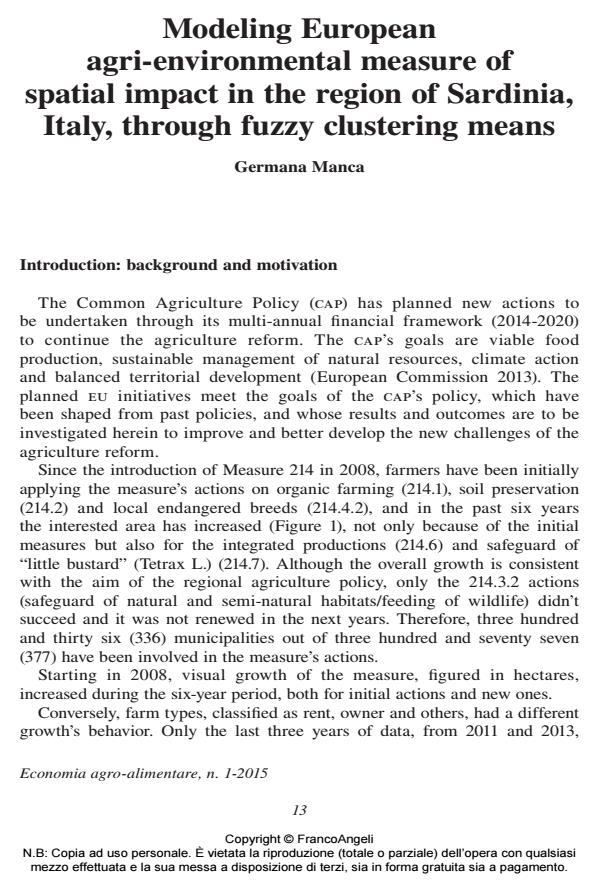Modeling European agri-environmental measure of spatial impact in the region of Sardinia, Italy, through fuzzy clustering means
Journal title ECONOMIA AGRO-ALIMENTARE
Author/s Germana Manca
Publishing Year 2015 Issue 2015/1
Language English Pages 15 P. 13-27 File size 352 KB
DOI 10.3280/ECAG2015-001002
DOI is like a bar code for intellectual property: to have more infomation
click here
Below, you can see the article first page
If you want to buy this article in PDF format, you can do it, following the instructions to buy download credits

FrancoAngeli is member of Publishers International Linking Association, Inc (PILA), a not-for-profit association which run the CrossRef service enabling links to and from online scholarly content.
The aim of this paper is to demonstrate how a spatial fuzzy clustering mean expands the knowledge of the European agri-environmental initiative impact, named Measure 214, in the Sardinia Region. While sketching out the geographic area covered by the measure for analysis and investigation using fcm is a fruitful approach, their integration with social and economic factors is an essential step in understanding agricultural growth and how it is influenced by environmental policy. This integrated approach shows how agri-environmental measures tend to develop in the region and, geographically, describes the spatial effects. Fuzzy clustering analysis demonstrates how decisions, whether they are related to the pursuit of policies moving towards the agri-environmental initiatives of organic farming and sustainable agriculture, or whether they concern ways of financing the measure’s activities, belong to the sphere of information, able to influence the new phase of agri-environmental financing and to keep it going. The spatial expansion of the measure all over the Region can help identify where the measure has taken root and in which directions it should be steered to achieve sustainable agri-environmental development in the area. Furthermore, the fuzzy cluster analysis highlights the relevance of the results, showing the policy direction that clusters should take in order to improve the measure’s effectiveness.
Keywords: Agri-environmental measure, fuzzy c-means, geographical information system, cap
Jel codes: Q15, Q18
- Visualizing regional clusters of Sardinia's EU supported agriculture: A Spatial Fuzzy Partitioning Around Medoids Pierpaolo D’Urso, Germana Manca, Nigel Waters, Stefania Girone, in Land Use Policy /2019 pp.571
DOI: 10.1016/j.landusepol.2019.01.030
Germana Manca, Modeling European agri-environmental measure of spatial impact in the region of Sardinia, Italy, through fuzzy clustering means in "ECONOMIA AGRO-ALIMENTARE" 1/2015, pp 13-27, DOI: 10.3280/ECAG2015-001002